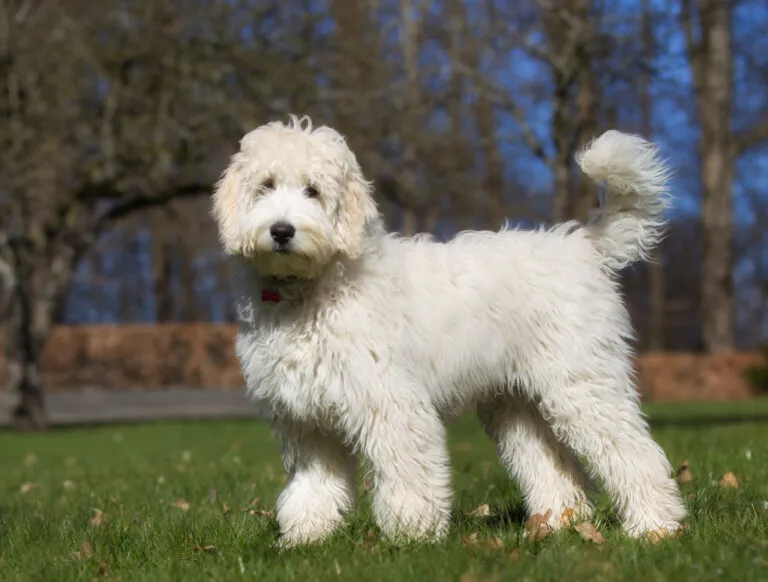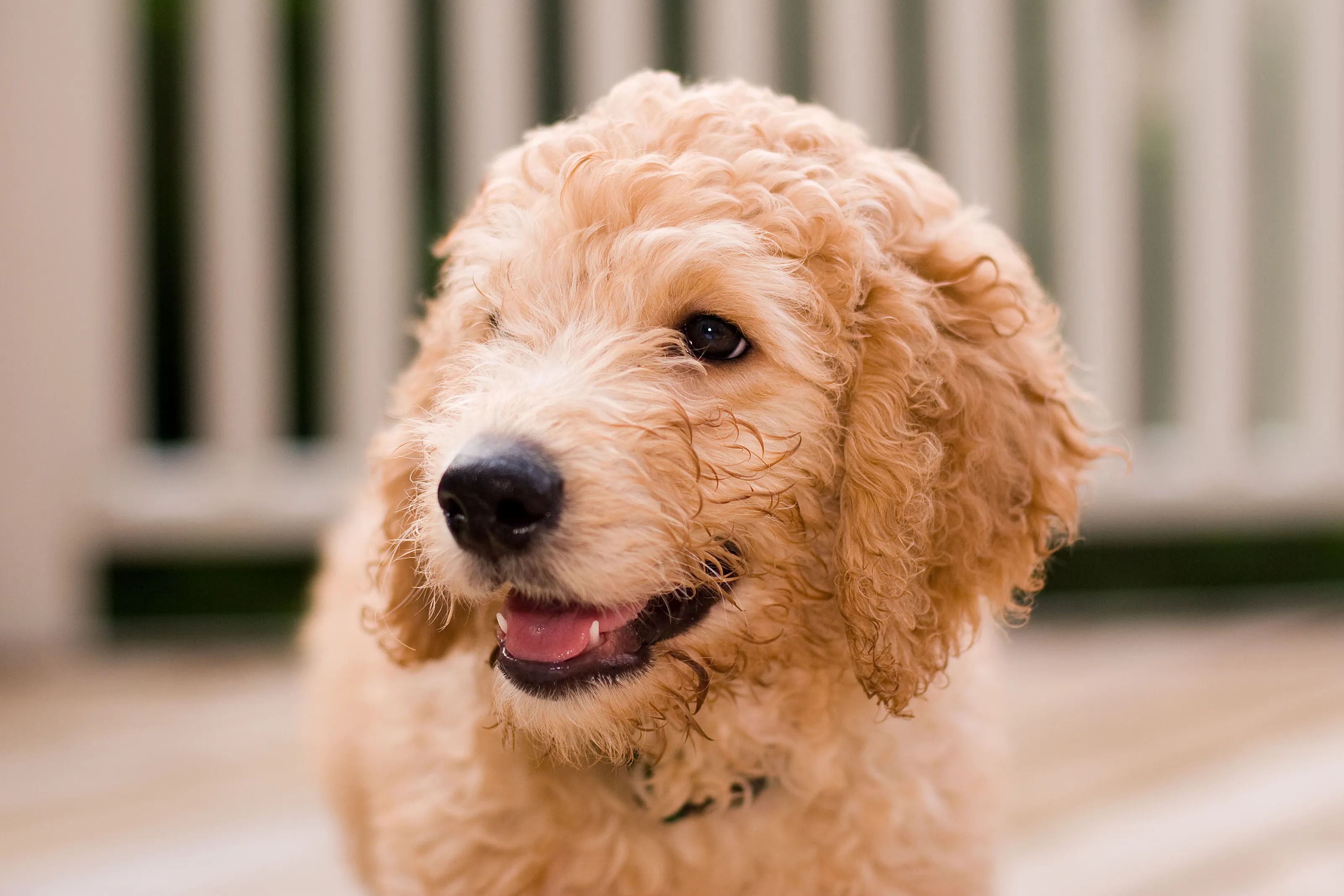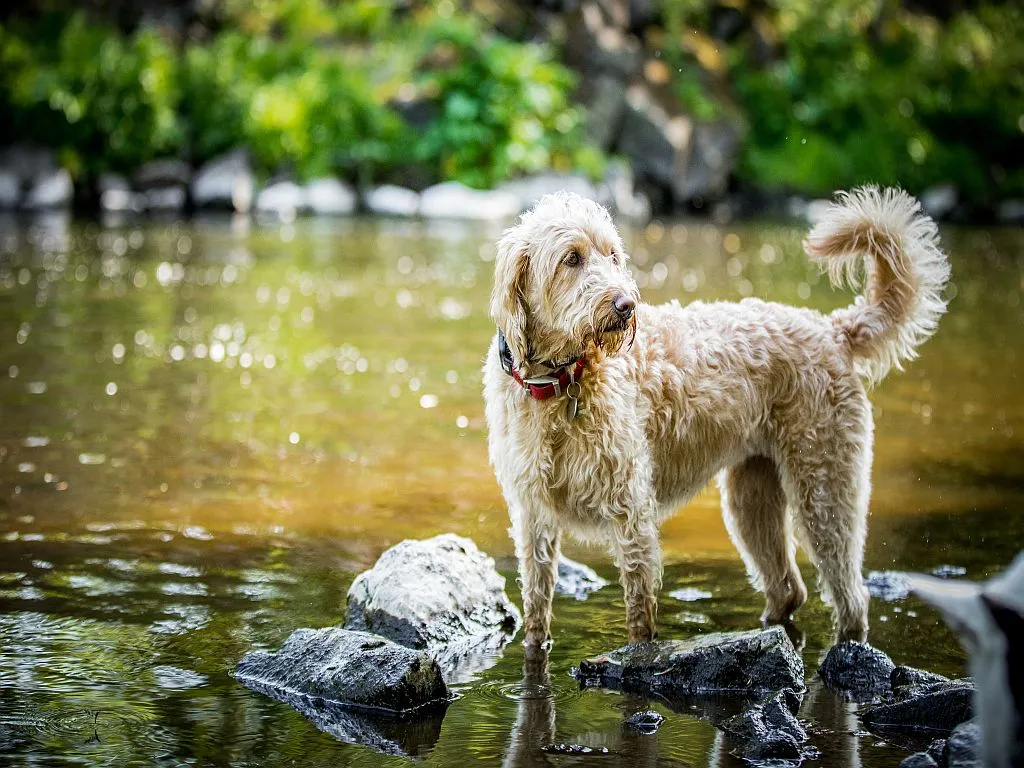Medium Size Poodle
The Labradoodle is a pioneer amongst designer dogs. Whilst there are serious endeavours in Australia to establish this Poodle and Labrador Retriever hybrid as a stand-alone breed, most specimens found in Europe aren't bred according to a standard.

© Mikkel Bigandt / stock.adobe.com
Since there is no uniform standard for Labradoodles living in Europe, they are usually a surprise package in terms of both looks and character. They are medium to large dogs since they can be traced back to the combination of Standard Poodles and Labradors. In subsequent generations, crossing Standard Poodles can also result in lighter dogs, although they are more disparate than the first generation. They are found in many different colours, with (almost) everything possible from cream white to black. It’s a similar story with fur texture too, as Labradoodles can have long or short, soft or coarse, curly or smooth fur. The aesthetic ideal for a Labradoodle is to resemble a teddy bear.
The story of the Labradoodle simultaneously marks the beginning of other hybrid breeds like Goldendoodles or Maltipoos. Breeding these hybrid dogs had the goal to combine the essence of Poodles with the characteristics of other breeds. Labradoodles marked the starting point in 1988. Wally Conron wanted a guide dog that didn’t moult for the Royal Guide Dog Association of Australia. A cross between the Labrador established as a therapy dog and the non-moulting Poodle aimed the joy of a four-legged guide to bring blind people suffering from an allergy to pet fur.
Conron himself has recently repeatedly expressed criticism of the consequences of his original idea and stressed that he created many problems with it. These include many people taking advantage of the opportunity to make money from the designer breed without having the necessary knowledge. Nowadays, this results in many sick and mentally unstable dogs. However, there are currently efforts to make Labradoodle breeding more professional. The Continental Kennel Club in the US has recognised the Australian Labradoodle as an independent breed. This is still a more distant prospect for Europe, where you won’t be able to acquire a Labradoodle with official paperwork. We will give tips on Labradoodle breeding at the end of the article.
Australian attempts to create a stand-alone Labradoodle breed are incredibly different to isolated Labradoodle breeders found in Europe. What’s the difference? If you cross two breeds, only the characteristics of the F1 generation can be predicted to some extent. From the next generation, the genes interact in a varied manner based on Mendel’s Laws. This is why we mostly only find breeders that cross Labradors with Poodles but not their offspring (F1 generation). A great deal of expertise is required to achieve a specific breeding goal. Australian breeders have accepted this challenge and developed the Australian Labradoodle. It is currently not permitted to crossbreed other Retrievers or Cocker Spaniels with this new breed in order to achieve the desired characteristics and stable health. Hence, the Australian Labradoodle has the chance to become an established breed in a few years.
 © Matthew Veldhuis / stock.adobe.com
© Matthew Veldhuis / stock.adobe.com
Labradoodles are usually as friendly as they look. However, their behaviour can only be predicted to a limited extent, since they are made up of two different breeds. Labradoodles are often cuddly, sociable and make good family dogs as long as they get enough exercise. After all, both Poodles and Labrador Retrievers can be traced back to hunting dog breeds, though you will only end up with a mentally stable Labradoodle if you choose responsible breeders. Many who are only out for a profit want to save themselves with Labradoodles the costs and effort of verified breeding animals as well as the expertise regarding breeding, and sell puppies with behavioural problems. These deficits may partly come from the parent animals that didn’t have to perform a character test or be caused by insufficient training. Such dogs can show fearful or aggressive characteristics.
Poodles mostly have a stronger hunting instinct than Labradors, so the Poodle aspects of the Labradoodle come to the fore more strongly if you give great importance to retrievability from the beginning. Be consistent in terms of training, because what you allow cute puppies to do will then become second nature for adult dogs. What applies to all dogs is particularly relevant for often undervalued working dogs like Poodles and Labradors: only even-tempered dogs can show their well-trained side. Attend puppy play sessions and dog school with your Labradoodle in order to learn together and perhaps make new friends.
 © SAJ / stock.adobe.com
© SAJ / stock.adobe.com
Is a hybrid automatically healthier than a pedigree dog? This is a misconception and can be a dangerous one, in particular with supposed pedigree parent animals without a family tree or healthcare provision, since both Poodles and Labrador Retrievers can have genetic deficits. Hence, parent animals should be tested for hip and elbow dysplasia and the ocular disease progressive retinal atrophy before they are deployed for breeding. X-rays are used to examine the joints, whilst ocular diseases are genetically determined. Talk to the breeder and get them to show you the results in writing.
The different fur texture of Poodles and Labradors can culminate in skin problems from itching to hair loss, since Labradors moult regularly but Poodles do not. Another compatibility problem results from the different snout forms. The Labrador’s snout is much wider than the Poodle’s, which can lead to malpositioned teeth and jaw problems.
Since Labradors have a tendency to be greedy and gain weight, you should keep an eye on their daily portions from when they are young. Make sure that you don’t just use treats as a means of positive reinforcement, but try stroking or little games too. Give them a high-quality food with plenty of meat and no grain. Adhere to the manufacturer’s guidelines. It makes sense to weigh the food to help you get a feel for the correct quantities. However, the manufacturer’s guidelines are for orientation only: dogs that get plenty of exercise or lose weight despite getting the recommended amount of food need to eat more. Also calculate little snacks and rewards as part of the overall daily quantity. If you want to give your dog something tasty to chew, opt for dried snacks like low-fat cattle ears or rawhide chew bones. Sugar has no place in the food or treats. Fresh drinking water should always be freely available to your Labradoodle.
Discover our selection of dog food!
Although the fur of these hybrid dogs can be very different, they usually have in common that they need plenty of grooming. The coat is often abundant and needs thoroughly brushing every two days so that it doesn’t get matted. Whilst Poodle fur doesn’t fall out, Labradors can moult heavily. Hence, it can’t be foreseen what will apply to the Labradoodle. Many Labradoodle owners regularly see a dog groomer with their canine companion to get it sheared. However, this isn’t beneficial with all fur textures.
You can usually let dirt in the fur dry and then simply brush it out. If you have to give your Labradoodle a bath, use a mild dog shampoo. If your canine companion has plenty of hair in its ears, they should be regularly cleaned with an ear cleanser for dogs, because painful inflammations can soon form that require veterinary attention. Make it a habit to take a look at your dog’s ears every time you brush it.
Both Labrador Retrievers and Poodles are originally hunting dogs. Both were deployed in the water, which is why Labradoodles usually enjoy swimming. They make excellent companions for long hikes and can also accompany you on bike or horse rides following relevant training once they are of adult age. Before you try out a type of dog sport like agility with plenty of jumping, you should ask your vet for advice. However, some Labradoodles are too heavy and don’t particularly enjoy this type of sport. Retrieval or learning little tricks bring occasional variety to day-to-day canine life. Man-trailing or other tracking work can also be an option. Last but not least, many Labradoodles are of course well suited to serving people as therapy or guide dogs. It’s best if these dogs come from a specific targeted breed, since they should show suitable character traits.
Labradoodles can live both in cities and the countryside as long as they get enough exercise and activity. Although, as with any dog, having a fenced garden is be ideal. Dogs from ethical breeders will be mentally stable and get on well with amicable fellow dogs. It can make a wonderful companion to children as long as they have learnt how to handle dogs. However, you should never leave small children alone with a dog. Many Labradoodles are good with cats if they have been socialised early on. Small animals like guinea pigs or hamsters will appeal to their instinct for hunting prey though. Be it for families or elderly people living alone, first-time or experienced dog owners, a Labradoodle is well suited to many dog lovers who enjoy spending time with their pet outdoors.
Do they offer allergy sufferers who want a dog the opportunity to live with a canine companion? Unfortunately there are no guarantees on this front. Labradoodles can moult abundantly, in which case this alone would make a Poodle a better option, since it doesn’t moult whatsoever. However, the allergens are in the dog’s saliva, not its fur. If you are an allergy sufferer, talk to your doctor before deciding on a certain dog.
If you want a Labradoodle, ask yourself first of all whether a Labrador Retriever or Poodle wouldn’t be a better alternative. These breeds are bred in a controlled manner, meaning that you have a much greater chance of finding a serious breeder who can present you with the family tree of your new canine housemate. This is more than just a piece of paper, as it shows the breeding suitability examinations carried out by the parents, a certain line of ancestors and a minimum level of control, since the breeder belongs to an association.
This isn’t the case with Labradoodles. Often the parent animals haven’t completed any breeding suitability examinations and therefore aren’t suited to this purpose. Consider too that it seems likely that the Poodles and Labradors most suitable for breeding will also be used for further breeding of their respective breeds. If it does have to be a Labradoodle, make sure there is written evidence of the health examinations carried out on the parent animals. Further, ask for their family tree too.
An Australian Labradoodle offers more reassurance. Suitable ports of call in Europe are the Australian Labradoodle Association Europe (ALAEU) or the Australian Labradoodle Founders Alliance (ALFA). In this context, the emergence of a new breed called the Cobberdog is interesting but questionable too. It is very similar to the Australian Labradoodle, but Irish Soft Coated Wheaten Terriers are amongst its ancestors too. A top tip if you’re looking for a charming adult companion is definitely to look in animal shelters!
Fans of the Bearded Collie agree that those who aren't familiar with this dog breed simply have to get acquainted with it. And those who have experienced how a Bearded Collie bolts across meadows with its flowing fur, how it rolls around full of energy and joy and how it attentively and observantly takes into account its owners wishes become simply addicted to this original dog breed and its unique charm.
The Goldendoodle isn't a breed, but a pairing between Golden Retrievers and Medium or Standard Poodles. Marketed as a low-maintenance dog for allergy sufferers, this hybrid is enjoying increasing popularity amongst dog lovers, similar to the Labradoodle.